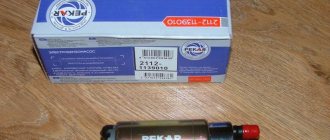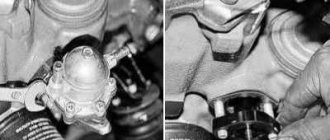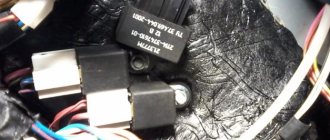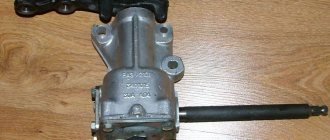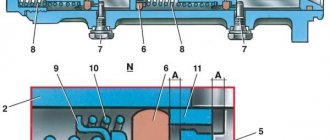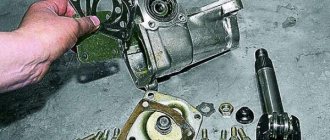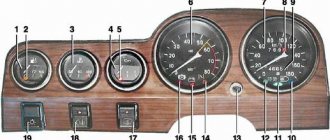1 – electric motor of the cleaner; 2 – washer motor; 3 – solenoid valve for turning on the windshield washer; 4 – mounting block; 5 – windshield wiper relay; 6 – ignition switch; 7 – ignition relay; 8 – switch for cleaners and washer.
Windshield wiper type 32.5205 consists of a gear motor, levers and brushes. The electric motor of the cleaner is three-brush, with excitation from permanent magnets, two-speed. To protect against overloads, a thermobimetallic fuse is installed in it.
Requirements for windshield wipers.
The windshield wiper circuit has several types of design.
With any design, windshield wipers must ensure cleaning of the windshield regardless of the amount of precipitation. Automotive windshield wiper drives usually have two speeds. It should ensure that the brushes are placed in the extreme position when turning off, which does not interfere with the driver’s view. On modern cars, the windshield wiper drive has an intermittent operation mode. It is provided by a thermal or electronic relay included in the power supply circuit of the wiper drive. This mode can be either with a constant period of time or adjustable. During intermittent operation, one or two cycles of brushes pass across the windshield with breaks of 3 - 5 seconds. In addition, on some cars, for example VAZ classic, the intermittent mode serves as a low-speed wiper drive.
On some imported cars, intermittent operation uses a smooth speed control, which is ensured by changing the voltage to the electric motor by an electronic unit.
What is the advantage of a relay with an adjustable pause
As a rule, all modern cars have at least 2 operating modes for windshield wipers: intermittent (that is, with a pause between sweeps of the blades) and constant. Have you ever encountered a situation where, during light drizzling rain, when the windshield wipers operate in the “pause” mode, this pause is too short and the wipers “scrape” on the windshield that has not yet gotten wet? I think most drivers have found themselves in similar situations. If your car does not have the ability to adjust the pause in the operation of the brushes, there are only two ways to solve the above problem. The first is to turn the wipers on and off as needed, but this distracts the driver from driving and creates additional risks for safe driving, especially if the trip is long. The second way is to leave everything as is, that is, to accept the movement of the brushes on dry glass, but this, firstly, leads to increased wear of the wiper cleaning tape, and secondly, it can irritate the driver.
A windshield wiper relay with an adjustable pause allows, by maintaining the required pause between sweeps of the wipers, to easily and most effectively solve the above problem, making travel in light rain conditions more comfortable.
There are two types of such relays:
- with several preset intervals between strokes (for example: 1, 2,4,8, 10 seconds, the driver can only choose the interval most suitable for current conditions;
- with the ability to set any required interval, i.e. Based on current conditions, the driver can set almost any interval using a certain algorithm.
Methods for connecting windshield wipers.
The connection diagram for windshield wipers can be divided into two types, depending on the method of connecting the operating mode switch.
In the first connection method, a constant plus is supplied to the wiper drive electric motor, and the mode switch connects the motor elements to the minus. This method is widely used in foreign and domestic cars.
The second method is completely opposite to the first, that is, power is supplied to the electric motor through the mode switch, and the minus in this case is taken from the drive housing.
I propose to consider the principle of operation of a car windshield wiper circuit using an example, where plus is supplied to the electric motor through a mode switch, since this is the more common connection method.
The diagram shows the connection of a windshield wiper drive with an electric motor powered by permanent magnets and having two operating speeds. The difference in speed in this circuit is ensured by the displacement of one of the positive brushes relative to the physical center of the electric motor armature.
VAZ 2109 tachometer does not work
The tachometer on the VAZ-2109 was installed only on cars with a high panel, and its connection diagram depended on which engine was installed, carburetor or injection. On “nines” with a carburetor engine, the signal to the tachometer comes from the ignition coil terminal, and in case of abnormal operation, troubleshooting should begin with the ignition coil terminal, to which two wires are screwed. There are cases when they are bent so that they are located next to the central high-voltage wire and in the event of a breakdown, the spark goes to these wires, which causes the tachometer to glitch. A similar picture occurs in the case of oxidation of these contacts. If the tachometer needle moves sharply in one direction or the other, it can be assumed that the culprit of this malfunction will be the switch, which will fail after some time. The tachometer, in fact, is an indicator of malfunctions appearing in the ignition system.
Windshield wiper circuit work.
Zero position.
The circuit consists of a fuse F, a three-position switch SA, a permanent magnet motor M and a limit switch SQ. The zero position of the SA switch corresponds to the off state of the vehicle's windshield wiper. If the switch is moved to this position after working, then the electric motor will stop only after the limit switch SQ is opened, which occurs when the wiper blades are in the extreme position.
Closing the electric motor brush with the SQ switch to ground leads to dynamic braking and a sharp stop of the electric motor, which prevents the moment of shutdown and re-supply of power to the electric motor brushes through SQ, which will lead to non-stop operation of the electric motor.
First position.
When switch SA is moved to the first position, power from fuse F through the switch contacts will flow to the motor brush and the drive will operate at low speed.
Second position.
If you turn on the second position, then the additional brush of the electric motor, displaced relative to the negative brush, will receive power, which will lead to a change in the magnetic flux of the armature and an increase in the rotation speed.
Slightly ahead of the sequence of events, so as not to forget, I’ll tell you an epic story about wipers... Everything went its way, birds sang around, the grass turned green and the bright sun was shining... But everything can’t be smooth, especially with the Russian automobile industry)) Trouble happened, my people got sick wipers, at first they started moving slower, then even slower, then very slowly, and when I changed the blades they stopped moving altogether) I scrolled through the Internet up and down and I want to share with you the chronology of actions in such incidents... There are not very many reasons for wiper failure , let's start with the simplicity of actions to solve the problem:
1. The first thing to look at is the fuses and relays, this does not require special knowledge and the waste of time is minimal...
We remove the cover from the mounting block; on the back side, as a rule, there is an arrangement of fuses and relays. If I'm not mistaken, fuses F4 (10A) and F5 (15A), and K3 are the windshield wiper relay... It all depends on what part you have. I would like to note that if the relay is faulty, speed 3 of the wipers should still work... If replacing the relay returned the missing 2 speeds, you don’t have to read any further) At the same time, move the cable to the mounting block (after all, this is the Russian auto industry =) Be sure to inspect the connector connecting the motor to h/i, clean, connect back. It didn’t help - move on... Try connecting the motor directly to the battery, if it works, then the problem is either a broken wire or a burnt track in the installation...
Components
To assemble this device, I needed the following components (follow the links to search for the best deals on Aliexpress for your convenience):
- Windshield wiper control handle from Opel Omega B. If you don’t find a handle with a wheel for your car, you can use a regular variable resistor. True, I don’t know about other knobs, but this one has a variable with fixed positions (8 in total), and not a regular twister. The firmware, of course, is designed specifically for such a variable, but this is not important, it can be converted to a regular one, and the circuit will not change.
- Microcontroller Atmel Atmega328P. In general, you can use a small Atmega8 instead of a large deep one - no matter who knows how to solder what. Of course, 8 kilobytes of memory is enough for such a simple project.
- The wiring for the MK is quartz at 16 MHz and 2 ceramic condensers at 22 pF. Don't you see that I used tubular ones - that was a mistake, because... In the sun, in extreme heat, the machine heats up, and their capacity apparently runs out, the arduino stops working. I’ve already bought ceramics, as soon as I get my hands on them I’ll change them.
- Optional - socket for MK. For Atmega328P-PU I used a ZIF socket, or a regular deep socket. And, of course, as an economical option (how much will you save here?) or if you use an SMD MK, you can stupidly solder it into the board.
- Any other Arduino with a shield - so that you can reflash this entire system “on the fly” for calibration after assembly. Well, or an empty shield into which you can transfer the MK microcircuit itself for firmware, unless, of course, you regretted it and soldered the socket into the device, and not the microcircuit itself.
- Layout - I used a cheap cardboard one, just like for my other projects.
- Resistors of different ratings - use what you have, in this circuit a difference in ratings is allowed, the main thing is to maintain the order and ratio in the dividers.
- A relay with a 12 volt ampere coil for 10. I used the Soviet RES-6, it is designed for switching circuits with currents up to 6A, it works as it should. You can also adapt a five-volt one, but its coil will consume more current, so you will need a more powerful transistor, plus all this will be powered through the stub, it will heat up more - why the hell do you need that?
- Transistor for controlling the above relay. Must be able to withstand the peak current of the coil of your chosen relay. The circuit is designed to use an NPN transistor, but PNP can also be added there with minor adjustments. Although, you can skip the transistor and take a ready-made relay for Arduino.
- A 5-volt stabilizer and a pair of electrolytic connectors for it in accordance with its datasheet. You can, of course, do without them, but why do you feel sorry for this little thing? I personally have a bunch of these little things lying around from soldered motherboards, with nowhere to put them. Instead of a stub, of course, you can use a dc-dc converter on the LM2596s, but it’s like shooting at sparrows with an anti-aircraft gun - it’s not worth it.
Here, it seems, are all the main components of the device. As you can see, most of them are ordinary, worthless waste. So everything is quite budget-friendly.
Windshield wiper system
Standard windshield wipers are designed to remove dirt, dust, and excess sediment from its surface. This allows you to increase visibility of the road at any time, including bad weather conditions: heavy rain or snow. For greater efficiency, the device is combined with a windshield washer, which sprays a special washer fluid under high pressure onto the glass surface. Thus, the glass is cleaned from adhering dirt and insects.
Automotive windshield wipers
Some cars have a rear windshield wiper, as well as special devices for cleaning the headlights (washers). This allows you to ensure traffic safety in all weather conditions. The frequency and duration of operation of the windshield wipers is regulated by the driver from the passenger compartment.
Diagram of the front and rear wiper VAZ-2110, 2111, 2112
Wiring diagram for the rear window cleaner and washer:
1 – washer motor; 2 – mounting block; 3 – ignition switch; 4 – rear window cleaner and washer switch; 5 – rear window wiper gear motor; K6 – additional relay; A – to power supplies; B – the order of conditional numbering of plugs in the gear motor block
Windshield wiper design elements
Design features depend on the type of device and the type of fastening elements. The standard windshield wiper circuit consists of the following parts:
- lever drive (trapezoid);
- leashes;
- relay for controlling operating modes;
- electronic control unit (if equipped);
- electric motor with gearbox;
- hinged fastenings;
- brushes
Design of windshield wipers
Additionally, control devices are provided. For example, for manual control, a steering column switch for windshield wiper operation modes is used, and for automatic mode, a special electronic control unit and a sensor for analyzing glass contamination (rain sensor) are installed in the vehicle.
Possible causes of wiper malfunction
A malfunction of the glass cleaner entails the risk of creating an emergency situation on the road during bad weather. Therefore, it is necessary to eliminate problems and their causes in a timely manner.
Wiring diagram for Gazelle wipers
Typical device problems are as follows:
- When turned on, the wipers do not work: the relay does not click, the electric motor does not work.
- The steering column switch does not work.
- The relay is activated, but the electric motor does not function.
- The relay and motor work, but the brushes do not move or move along the wrong path.
- Intermittent mode does not work.
- Slow work.
How the device works
Despite the simple functionality of the cleaning system, it is necessary to understand how windshield wipers work. Key details you need to know:
- The electromagnetic relay receives the control command and sets the operating mode of the brushes. Depending on the vehicle, the wipers may operate intermittently at short intervals of 3-5 seconds, continuously move at a set speed, or enter wash mode with the washer on.
- The windshield wiper motor receives power from the on-board electrical system. The exact connection diagram depends on the car model.
- The windshield wiper arms, and along with them the glass cleaning brushes, are driven by an electric motor with a worm gear and a lever drive (trapezoid). The trapezoid transmits and converts rotational motion from the electric motor to brushes, which, pressing tightly against the working surface, remove dirt and moisture from the glass.
A properly configured system should not leave streaks or mechanical damage on the surface of the glass, or make noise during operation. In case of such problems, it is necessary to promptly eliminate the malfunction.
How does a trapezoid work?
The windshield wiper trapezoid consists of a system of rods and levers that convert the rotational movement from the gearbox into the reciprocating movement of the leads with brushes. A standard device should perform the following functions:
Installation process
The windshield wiper relay with adjustable pause is easy to install yourself. To do this, you need to find the brush block and open the cover on it. There used to be an old relay here. Ideally, the new control unit has been modified and can be easily installed in an existing mounting location.
After this, you need to configure the system. After installing all elements of the system in the reverse order, it is necessary to turn on the intermittent wiper movement mode. In this case, the pause will last the standard amount of time. Next, you can set your settings.
To do this, the driver must turn off the brushes. After this, it maintains the required time interval. For example, it will be 2 seconds. Then the driver switches on the intermittent brush movement mode again. In this case, the relay will remember how often you need to sweep the wipers. This is a very convenient way to control the movement of the brushes.
Purifier management
The windshield cleaning system can be controlled in two ways - electronic and electrical. The last option involves manually changing operating modes. Under the steering wheel there is a special control lever that allows you to turn on the device, adjust the pause in the wipers and change the cleaning modes. But this option requires constant driver participation.
Understeering's shifter
The electronic control system is completely autonomous and does not require human intervention. The car is equipped with a special electronic unit and a rain sensor, which analyzes the cleanliness of the glass and weather conditions. Electronic control provides a range of functions:
- automatic switching on and off;
- changing the operating parameters of the purifier;
- blocking the motor in the presence of obstacles on the windshield;
- additional cleaning with windshield washer;
- preventing brushes from freezing when the engine is off.
Features of relay replacement
Before making a replacement, you need to consider the technology for carrying out this work. It is advisable to study the manufacturer's instructions. It indicates how the wiper control system works.
In some models this procedure is simpler. Many foreign-made cars have a system modification feature. The fact is that vehicles are supplied to the market with both full and cheaper equipment. In the second option, the manufacturer initially assumes that the driver can carry out modifications if desired.
If an additional control unit is installed on a similar foreign car and a domestic car, the procedure will be different. The windshield wiper relay with an adjustable pause for Grant, Priora, and VAZ is somewhat more difficult to install. However, when purchasing a modified used part, this procedure is greatly simplified.
Types of brushes
Car manufacturers provide car owners with a choice of brush types. Depending on the design and operational characteristics, they can be of the following types:
Frame brushes
- Frame brushes are the best and affordable option. They adapt well to the working surface of the windshield, but deteriorate the quality of cleaning at sub-zero temperatures and high speeds.
- Frameless wipers are a more expensive option that provides high-quality glass cleaning. The device is more resistant to freezing and also lasts longer. Among the disadvantages, it is necessary to note the difficulty of selecting brushes to ensure proper fit to the glass.
- Hybrid windshield wipers - these are often called winter wipers due to their closed design and moisture resistance. Ideal for regions with low temperatures, where it is important to ensure the functionality of the cleaning system.
Frameless wipers
Motor repair
Many people think that replacing the motor with a similar one from a foreign car can solve the problem with the slow operation of the wipers, but in fact, it is often enough just to clean and lubricate the “original” engine.
If the speed of operation causes complaints, then it is necessary to check how easily the armature rotates: if movement is difficult, damage or excessive wear of the brushes should be suspected. They are easy to replace with new ones.
Cleaning the collector will also help - this will require fine sandpaper. The need for this procedure is said:
It will be necessary to replace the armature or gearbox along with the complete motor if the manifold is too worn or burnt.
Adjusting the operating speed is necessary if the windshield wipers operate too slowly. This is facilitated by:
Eliminating these problems basically makes it possible to speed up the wipers and, moreover, significantly.
Methods for attaching brushes
Before 1999, most car manufacturers used a type of mounting for OEM windshield wiper blades called a "hook" or "hook". This is a universal device in the shape of the letter “U”, which allows you to snap the brush into place and not worry about the reliability of its installation. The following types of mounts are currently gaining popularity:
- Side pin - appeared in 2005 on BWM, Volvo and other cars. Allows brushes to be fixed using a special 22 or 17 mm side pin.
- Button or “Push Button” is an adapter for standard 16 mm wide wiper blades. It is enough to snap the device into place for fastening, and to remove it you need to press a special button.
- Pin lock - fixation of brushes using a special built-in lock. Used in Audi cars.
“Push Button” mounting scheme
This is not a complete list of types of fastenings. Each manufacturer can use their own designs for fixing brushes.
Despite the relative simplicity of windshield wipers, it is difficult to imagine a modern car without them. Drivers can control the operation of the wipers directly from the cabin, remove dirt and improve visibility of the road situation. And electronic systems automatically monitor the cleanliness of the glass, increasing the comfort and safety of driving without human intervention.



